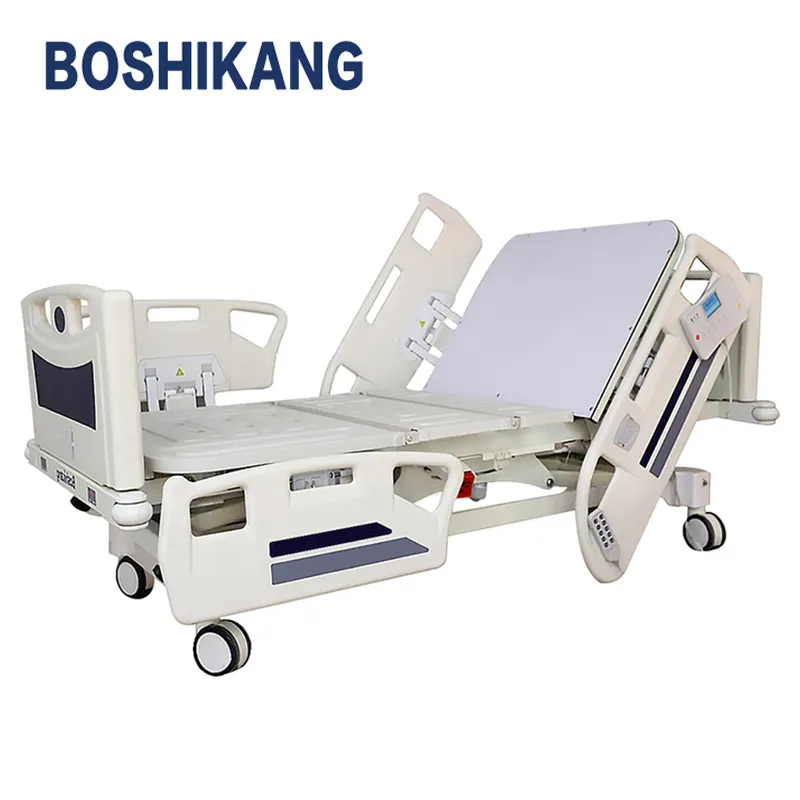Ergonomic Design and Adjustability in Patient Hospital Beds
Customizable Positioning for Optimal Comfort
Hospital bed designs that focus on ergonomics really matter when it comes to making patients comfortable by letting them change positions as needed. These adjustable beds give people the ability to find what works best for them personally, something that makes all the difference during long stays at the hospital. Research published in Advances in Nursing Science found around 9 out of 10 patients felt less uncomfortable when allowed to set their own sitting or lying positions, which naturally improves how satisfied they are with their care. But these adjustments aren't only about feeling good. They actually help manage various health problems too. Take someone struggling with breathing difficulties, for instance. Beds with height settings let those individuals raise themselves up, making it easier to catch their breath and potentially speeding up healing time.
Impact of Adjustable Head and Foot Sections on Recovery
The adjustable head and foot parts on hospital beds really matter when it comes to how fast patients get better. When hospitals set these beds at different angles, patients find it easier to breathe, their blood flows better, and they generally feel more comfortable while recovering. Research from Critical Care Medicine backs this up too. They looked at what happens when nurses raise the head section to about 45 degrees, and saw big improvements in breathing and oxygen levels for folks with lung issues. Nurses appreciate these adjustments as well because they make day-to-day tasks much smoother. Think about changing bandages or running tests – everything becomes simpler when the bed can be positioned just right. Better care for everyone involved makes these adjustable beds something most modern hospitals just cant do without anymore.
Pressure Redistribution and Skin Health
Preventing Bedsores with Advanced Mattress Technology
The latest mattress tech really makes a difference in how pressure gets spread out across the body, something super important for avoiding those nasty bedsores. We all know what happens when someone sits or lies in one spot too long their skin starts losing blood flow because of constant pressure, especially bad news for folks who can't move around much. Modern mattresses these days come packed with special materials and clever designs that take stress off sensitive spots on the body, cutting down on bedsores quite a bit actually. According to research from hospitals, people sleeping on regular old mattresses tend to get sores way more frequently compared to those lucky enough to have access to these fancy pressure distributing models. And let's not forget the money saved by hospitals either treating bedsores costs tons of extra cash for longer stays in the hospital plus all sorts of treatments nobody wants to deal with.
Airflow Systems for Moisture and Temperature Control
Airflow systems built into modern hospital beds help manage both moisture levels and temperature, which is good for overall skin condition. They work by creating what doctors call an ideal microclimate right where the skin meets the mattress surface. Studies show these airflow features can really cut down on skin problems because they stop sweat from building up and keep things from getting too hot. For folks with delicate skin or anyone who tends to develop rashes easily, this kind of system makes a big difference. The actual technology behind it all keeps skin surfaces drier and cooler than traditional bedding would, offering extra defense against those nasty pressure sores and other skin infections that often plague long-term bedridden patients.

Mobility and Accessibility Features
Height Adjustability for Safe Patient Transfers
Adjusting the height of hospital beds makes all the difference when it comes to safely moving patients around. Nurses and staff can raise or lower the bed to match whatever task they need to do, which cuts down on back pain and accident risks during those transfers. Research backs this up too many facilities report fewer injuries overall since switching to adjustable beds. Beyond just safety, patients actually benefit from being able to tweak their own bed heights. Someone recovering from surgery might prefer sitting up higher to eat breakfast, while another person could find lying flat more comfortable at night. This control gives them some say over their environment, something that often gets lost in hospital settings where everything feels so controlled already.
Wheeled Bases and Locking Mechanisms for Stability
Hospital beds equipped with wheeled bases and locking systems offer better movement options and greater stability, something really important in fast-paced medical facilities where things change constantly. The wheels let staff move beds quickly from one area to another, which means they can respond faster when someone needs urgent attention. Plus, those locks keep the bed firmly in place during procedures or transfers, so there's less risk of it shifting unexpectedly. Most modern locking mechanisms meet industry safety regulations that focus heavily on preventing slips and falls. While these beds work well in standard wards, some specialized units might need additional modifications for certain treatments. Still, the basic design provides flexibility without compromising on safety requirements for everyone involved.
Safety Innovations in Modern Hospital Beds
Bed Exit Alarms and Fall Prevention
Bed exit alarms are really important for preventing falls in hospital settings. When someone needs help gets up from bed, these devices let staff know right away so they can jump in before anything happens. A study published by the Journal of the American Geriatrics Society found that hospitals using these alarms actually had fewer fall incidents overall. This shows just how effective they can be against the dangers posed by limited mobility. Adding bed exit alarms to standard care practices makes a big difference in keeping patients safe. People who might otherwise fall get help faster than ever before. Plus, both patients and medical teams feel better knowing there's an extra layer of protection in place. The alarms allow for quicker reaction times when someone tries to move around without proper support.
Durable Side Rails and Weight Capacity Standards
Side rails that last long are really important for keeping patients safe since they stop people from falling out of bed. They also match up well with what hospitals require regarding how much weight beds should hold. The rails give extra help to folks who might slip off otherwise, so patients stay secure when resting or moving around. According to studies done by groups like the International Electrotechnical Commission, most beds need to handle between 300 and 500 pounds to work properly for different kinds of patients. Health authorities including the IEC stress good rail design because it helps maintain balance while caring for someone. Following these rules matters a lot both for protecting patients and making sure everything runs smoothly within medical facilities.
Electric Hospital Beds: Enhancing Care Efficiency
Remote-Controlled Adjustments for Patient Independence
When hospitals install electric beds with remote controls, patients actually gain more independence and feel better about themselves during their stay. The ability to change position whenever needed makes a big difference for people trying to manage daily routines while recovering. Research shows most patients report feeling happier when they have control over their own bed settings, which naturally leads to greater comfort levels. Plus, these adjustable features really cut down on what nurses and other staff need to do throughout the day. Without having to constantly help every patient reposition themselves, medical teams can concentrate on more urgent tasks that truly matter for recovery. That's why many facilities are now seeing electric hospital beds not just as fancy equipment, but essential components that improve both how comfortable patients are and how efficiently hospitals operate overall.
Integration with Smart Monitoring Systems
When electric hospital beds get connected to smart monitoring systems, they give doctors and nurses a much better picture of how patients are doing right now. The systems actually read information from sensors built into the mattress itself, then send warnings when something about a patient's condition starts changing in ways that need attention. Take pressure sores as an example. If the system detects someone has been lying in one position too long, staff gets notified quickly enough to reposition them before serious damage happens. Looking ahead, we might see beds that can predict problems before they occur or automatically adjust themselves based on what the sensors detect. Hospitals already using this tech report faster response times during emergencies and fewer complications overall. What matters most is that these technologies aren't just fancy gadgets but practical tools making a real difference in daily patient care.
The Role of Hospital Beds in Accelerating Recovery
Reducing Muscle Atrophy Through Positioning
How hospital beds are positioned matters a lot when it comes to stopping muscle loss in patients who spend too much time lying down. This is actually a big problem for people staying in hospitals for weeks or months. Research indicates that moving patients around regularly helps keep their muscles working properly and stops them from getting stiff and weak after being inactive for so long. A recent study published somewhere (can't remember the exact journal name) found that folks who get turned over several times a day tend to hold onto their muscle strength better than those left in one position. When muscles start wasting away, recovery gets harder. Patients need physical therapy for longer, hospitals end up spending more money on treatments, and overall life gets worse once they leave the facility. Because of all this, making sure beds are set up correctly isn't just about comfort anymore. It's become pretty much essential for anyone wanting good results from their treatment and hoping to stay healthy beyond discharge.
Psychological Benefits of Comfortable Bed Environments
When hospitals equip their facilities with beds that are both comfortable and adjustable, they're actually doing something important for patients' mental state which affects how fast they recover. Research shows there's a real connection between feeling good emotionally and getting better physically. Most nurses will tell anyone who asks that when patients wake up in a setting where they aren't constantly uncomfortable, their whole attitude changes for the better. A recent look at data from several hospitals found that people staying in rooms with adjustable beds reported less stress during their stay and generally felt more positive about their treatment outcomes. Looking at patient care through this broader lens means considering what makes someone feel safe and relaxed while they heal. That's why many healthcare providers now see spending money on quality beds as an investment in both body and mind rather than just another line item on the budget.


